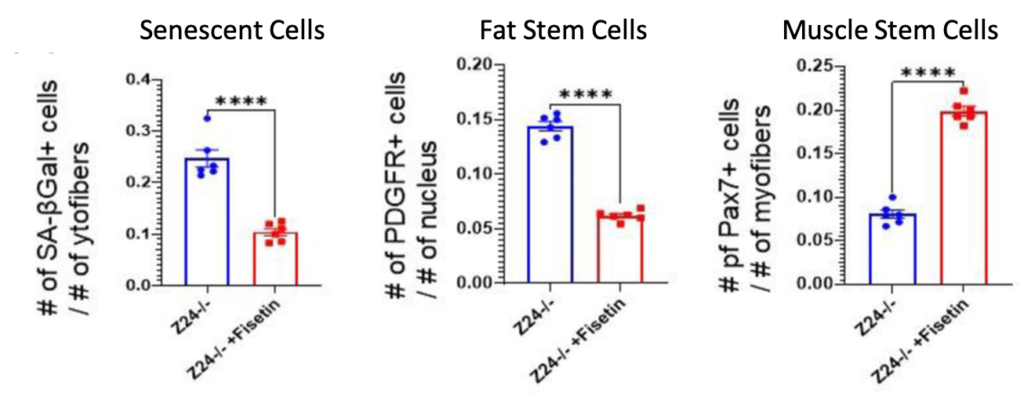Scientists Increase Muscle Size and Strength by Restoring Stem Cells with Senolytic Agent
The senolytic fisetin increases the muscle size and strength of prematurely aged mice by increasing muscle stem cells and reducing fat stem cells.
Highlights:
- Senolytics selectively eliminate senescent cells — capable of making other cells dysfunctional.
- The senolytic fisetin increases the muscle strength and size of mice while reducing tissue scarring.
- Fisetin reduces senescent fat stem cells, which increases the proportion of functional muscle stem cells needed to regenerate muscle and promote growth and strength.
The older we get, the weaker we tend to become, largely due to muscle atrophy (shrinkage) and reduced strength. While weakness can be countered by resistance exercise, with age our muscles become less capable of regenerating or growing. This lack of regenerative capacity is related to impaired muscle stem cells. Now, researchers are getting closer to rejuvenating aged muscle by restoring stem cell function.
Scientists based in the United States and China report in the Journal of Cachexia, Sarcopenia and Muscle that the senolytic fisetin rescues stem cell function in a mouse model for premature aging (progeria). Liu and colleagues show that fisetin, while increasing muscle cell size and strength, decreases the formation of non-living scar tissue in the muscle of progeria mice. Fisetin also decreases senescent fat stem cells and increases muscle stem cells in the muscle of progeria mice. These findings suggest that fisetin can help restore muscle regenerative capacity.
Senolytics Restore Muscle Growth Capacity and Strength
Hutchinson-Gilford progeria syndrome is a genetic disease associated with premature aging (progeria) that causes muscle atrophy. Liu and colleagues fed mice modeling progeria 100 mg/kg of fisetin once per week for 4 weeks. In addition to reducing muscle atrophy, fisetin treatment decreases the formation of scar tissue (fibrosis), which impairs muscle regeneration and is a major cause of muscle weakness. Fisetin also increased the strength of the progeria mice, as measured by how long they could hang from a bar.

Muscle stem cells lose their ability to proliferate and form new muscle cells with age, but the reason for this is unclear. Fibrotic-fat stem cells (fibro-adipogenic progenitors) interact closely with muscle stem cells to facilitate muscle regeneration. However, in disease states, these fat stem cells promote fibrosis and fat deposition. Furthermore, when fat stem cells enter a senescent state, they secrete molecules that impair surrounding cells, including muscle stem cells.
Liu and colleagues found that fisetin treatment eliminated senescent cells in the muscle of progeria mice, as expected from a senolytic. They also found that fisetin reduced the number of fat stem cells, some of which could have been senescent. Furthermore, fisetin increased the number of muscle stem cells, suggesting that their proliferative capacity had been restored. Along with other experiments, these findings suggest that fisetin restores muscle stem cell function by eliminating senescent fat stem cells.

Overall, it would seem, from the findings of Liu and colleagues, that fat stem cells could accumulate with aging to increase fibrosis and fat deposition, leading to muscle weakness. These fat stem cells, and probably other muscle resident cells, could become senescent and impair muscle stem cells, leading to diminished muscle regenerative capacity. By eliminating senescent cells, namely senescent fat stem cells, fisetin can restore muscle regeneration, leading to increased muscle growth and strength.
Senolytics May Reverse Muscle Aging & Prolong Lifespan
With senolytics like fisetin on the cutting edge of aging science, human studies measuring their effect on muscle decline have been limited. One study, however, showed that 10 mg/day of the senolytic quercetin was associated with reduced odds of frailty in middle-aged and older adults. The muscle of older adults also has more senescent cells, which has been associated with reduced strength. In mice, the senolytic combo dasatinib plus quercetin D + Q improves muscle regeneration and muscle-building potential in old age. Therefore, senolytics could possibly prevent or reverse signs of muscle aging.
The importance of maintaining muscle mass and strength cannot be understated, as reduced grip strength is associated with an increased risk of mortality. Several studies, including one from the United Kingdom (U.K.) and one from China, have shown an association between reduced grip strength and increased risk of death. Another study revealed that low grip strength is associated with an increased risk of death from various types of cancer. Furthermore, a recent study showed that reduced grip strength is associated with accelerated aging. Thus, maintaining strength may be important for living a long life.
Model: Z24-/- mouse model for progeria
Dosage: 100 mg/kg fisetin weekly via oral gavage for 4 weeks

